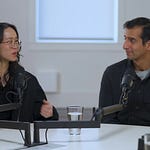This 8-minute clip of Tim Ferriss on the Huberman Lab Podcast is pure genius.
In it, Ferriss distills his unique method of practical futurism, which helped him identify the early trends that led to the success of The 4-Hour Work Week and The 4-Hour Body.
For example, with the 4-Hour Body, he was early on wearables, continuous glucose monitors, and ice baths. With the 4-Hour Work Week, he was early on using virtual assistants and designing passive-income lifestyle businesses.
In the interview clip, Ferriss breaks down his approach more than he has anywhere else. Ultimately, it comes down to just four things:
Find holes in mainstream thinking with three words
Look for three types of weak signals of future breakthroughs
Look for hidden innovations, which are new, old, or orphaned
Ask experts these four questions to uncover their unspoken secrets
Post Preview
In the free version of this post, I breakdown the Ferriss Formula.
In the paid version of this post:
I breakdown how the Ferriss’ Formula fits into the larger landscape of mental models on practical futurism.
I provide you with a Megatrend Tracker GPT (and the prompt I used to create it). It shares the largest tech and social trends that are not widely known along with their second-order effects. You can further prompt the GPT to search trends by industry. I’ve actually learned about a fair amount of trends using this tool.
Let’s jump into the Ferriss Formula…
Step #1: Find Holes In Mainstream Thinking With Three Words
[I look] at the most prevalent beliefs and maybe dogmatic assumptions in a given field. Could be anything. If anyone says, “Always, never, should,” I pay attention and take note of that. They may very well be right. But if anything is said in absolutes, I like to stress test.
—Tim Ferriss
The fundamental goal of any thought leader should be to find ideas that are both rare and valuable…
If you share something that everyone already believes, your idea will be cliche and boring. Therefore, it will be ignored. Instead, you should search for ideas that contradict mainstream beliefs.
From there, most contradictory beliefs aren’t more valuable than conventional wisdom because conventional wisdom is based on years of collective trial and error. So you want to find the rare ideas that are also more valuable than conventional wisdom.
What I love about Ferriss’ approach that I haven’t seen elsewhere is that he looks for three words that indicate dogma from conventional wisdom that is worth exploring:
Always
Never
Should
10 Other Words That Indicate Dogma (According To ChatGPT)
PROMPT
What are keywords like Always, Never, or Should that indicate someone may be dogmatic in their beliefs? List 10 words with no explanation. Do not include always, never, or should.
KEYWORDS
1. Must
2. Impossible
3. Unquestionable
4. Certain
5. Absolutely
6. Clearly
7. Undoubtedly
8. Obviously
9. Definitively
10. IrrefutableStep #2: Look For Three Types Of Weak Signals Of Future Breakthroughs
So I'm never predicting the future. I'm just finding the seeds that are germinating that I think are going to bloom and end up spreading really, really widely.
—Tim Ferriss
A weak signal is an early indication of a potentially significant future trend, change, or disruption that is not yet widely recognized or understood. Ferriss discusses three types of weak signals for future trends:
Technological
Social
Early Adopters
A. Technological Signals
In the case of, say, physical performance or physical manipulation, tracking 2008--2009 was a very interesting time because a number of different technologies were coming online, meaning being adopted by small groups. You had the very early stages of, say, accelerometers. As wearables, you had a number of different innovations and means of tracking that had never been available before. You had, for instance, and this took a bit of ferreting on my side. It wasn't immediately on the roadmap for the 4-Hour Body, but continuous glucose monitors. At the time, that was, I want to say, exclusively limited to Type 1 diabetics or maybe Type 2 Diabetics, but largely Type 1 Diabetics.
Which then led me to use the very early versions of Dexcom, which were really painful to implant? No longer the case, of course. That's changed a lot.
—Tim Ferriss
Ferriss found early-stage wearables (accelerometers, continuous glucose monitors, etc) when they were still not widely known, expensive, less reliable, and painful.
With all technology, the first versions are:
More expensive
Less effective
Less reliable
More risky
More confusing
More time-consuming
Ferriss’ approach is diametrically opposed to most people. Most people give up when they try something new and it doesn’t work perfectly out of the box or is confusing. I can’t tell you how many people I’ve talked to who gave up on AI because the first responses they got back from ChatGPT weren’t super useful.
Skilled early adopters, on the other hand, are willing to take on various forms of difficulty in return for being early. Being the first to see and then definitively share something is critical to thought leadership.
B. Social Movement Signals
And what captured my interest, and I can't recall how I came across it, but it was probably through the very earliest iterations of what later became the Quantified Self-Movement. And I remember attending the very first gathering at Kevin Kelly's house in Pacifica, California. This was around 2009, 12 people, 13 people to discuss quantifying health.
—Tim Ferriss
Just as technology starts off expensive and unreliable, social movements start out as small groups of interesting people doing things for fun.
Most people wait until a trend is popular until they trust it. Skilled early adopters are willing to try out things before they’re mainstream.
Furher Reading: The next big thing will start out looking like a toyC. Early Adopter Signals
But the the example of a professional race car driver, I can't remember the form factor, whether it was F1 or NASCAR or other who was using this continual glucose monitor for paying attention to glucose levels while driving.
And I thought to myself, “Would that not be useful for healthy normals? Would that not have other applications? If this is being used by a high performer in this type of context, might it have other types of applications?”
—Tim Ferriss
And I assume the practitioners are going to be ahead of the papers. So I'm studying, say, the coaches whose jobs are on the line, who are getting paid based on athlete performance, and assuming that a lot of that will eventually, if it holds up, make its way into, say, the peer-reviewed exercise science papers. But it's going to have a lag time of 3 to 5 years at least.
—Tim Ferriss
So the the very beginnings are usually in some type of extreme case… The extremes inform the mean but not vice versa. So you can actually learn a lot by studying the edge cases.
You'll often see things start with, say, racehorses, or people with wasting diseases, for instance, or any type of chronic or terminal illness who are willing to try some more experimental interventions. Then let's just take one step further—bodybuilding. You see a lot of interesting behavior in bodybuilding and high-level athletes, then billionaires, then rich people, then the rest of us. Right.
—Tim Ferriss
Ferriss observes that early adopters of innovations that increase performance predictably fall into four buckets:
Top performers who will do anything they can to get the extra edge.
Nerds who can actually build the tech.
Rich people who can afford to pay for tech before it becomes affordable for the masses.
People with chronic or terminal illnesses who are willing to take risks other wouldn’t in order to improve their condition.
Step #3: Look For Hidden Innovations, Which Are New, Old, Or Orphaned
And I wanted to see how I might be able to find a handful of different categories of things:
New. There's the new, like the genuinely new like CGM [continuous glucose monitor] at that point was genuinely new.
Old. The very old that might have some room for scientific investigation. And I would say when I say scientific, I don't necessarily mean randomized controlled trials at a university. I do think as an N Of 1 [single person experiment], if you think about study design and you can even blind, you could even placebo control. And I knew people in the small subculture of quantified self who did this.
Orphaned. So, for instance, there are many examples in the world of doping where you have, say, BALCO back in the day, where famously Barry Bonds and others purportedly used things like the cream and the clear, and these were based on anabolics that were sourced from Soviet literature or older literature from the 50s and 60s that might not be on the radar of, say, the anti-doping groups that would administer the testing.
—Tim Ferriss
So the question becomes, where do you find things that work that aren’t widely known? Said differently, what valuable ideas has the mainstream overlooked?
The most obvious answer is new, cutting-edge things that haven’t spread yet. But, Ferriss adds two new places to search.
First, society has a short-term memory. Many things that work are eclipsed not because they become outdated, but simply because people’s attention moves on to the next bright, shiny object. Therefore, looking to the past is a powerful approach.
Second, many things are orphaned because they were taboo at a certain time. In the Huberman interview, Ferriss referencess to athletic doping. I’ve also seen ideas be orphaned when there is backlash against an idea, and the academic world dismisses all of someone’s ideas as a result thus throwing the baby out with the bathwater.
Step #4: Ask Experts These Four Questions To Uncover Their Unspoken Secrets
And I begin where I usually do, which is interviewing folks. So I would interview 1 or 2 people in a given field and I might ask them any number of questions:
#1: What are the nerds doing on the weekends or at night?
This is also really good for investing. It's like, all right, what are the really technical nerds doing at night or on the weekends after they've put in a really long workday or workweek?#2: What are rich people doing now that everyone, or tens or hundreds of millions of people might be doing ten years from now?
And an example of that would be, let's just say full-time assistant. Virtual assistant. So we've seen the needs and wants being addressed by different technology, but it's an iteration of the same thing on some level. In the case of, say, using ChatGPT tied into Zapier for various functions.#3: Where are people cobbling together awkward solutions?
So where are people piecing together awkward solutions, and is there room for some type of innovation there?#3: Who are two of your close friends or two thinkers you really pay a lot of attention to?
A few years prior to writing The 4-Hour Body, I spent time at NASA Ames and was interacting with a number of scientists, some people who were working on all sorts of biological tests and looking at genomics, and had a very frank discussion. And then I would ask that person who's clearly, like, willing to step outside of the box of whatever he's working on day to day.
Ferriss doesn’t wait for ideas to be published online somewhere. He goes straight to the experts living in the future who haven’t broadly shared their ideas yet. Then, he asks four questions that help him extract their best emergent ideas.
Ferriss also points out that it is valuable to find where people are cobbling together awkward solutions. This is valuable to look for because it’s a signal that:
People have a strong need that they’re willing to invest time and money into.
That need is being unmet.
There is an opportunity for a company to come in and meet that need better.
Ferriss explains more about the power of following unmet customer needs in the following video:
Then, in another video, he shares how to find out what nerds are actually doing on nights and weekends:
Paid Subscriber Bonuses
For a long time, I thought that futurists were people who just used unproven approaches to make wild predictions that often didn’t come true. In other words, I put futurism in the category of sci-fi.
Now, I look at futurism as a practical skill that the world’s top innovators ALL understand. Not only that, as tech becomes more interwoven into society, futurism becomes more useful for everyone to understand at a basic level.
What I now see is this:
Predicting the future is something that we all need to do.
While nothing is certain, much more of the future is predictable than I thought.
There are proven approaches to predicting the future that the top innovators, thought leaders, and futurists use.
In particular, the pace of AI progress, has really lit a fire under me to understand the top mental models for futurism.
Below is a deeper understanding of the way I see things now along with a GPT I created to help you find early and reliable signals of technological and social change.











